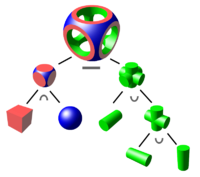
Photo from wikipedia
This study concerns the development of a numerical methodology for initializing immersed interface-based CFD solvers for using complex computer-aided design (CAD) geometry. CFD solvers with higher-order discretization stencils require larger… Click to show full abstract
This study concerns the development of a numerical methodology for initializing immersed interface-based CFD solvers for using complex computer-aided design (CAD) geometry. CFD solvers with higher-order discretization stencils require larger stencil widths, which become problematic in regions of space where insufficient mesh resolution is available. This problem becomes especially challenging when convoluted triangulated surface meshes generated from complex solid models are used to initialize the cut-cells. A pragmatic balance between desired local geometry resolution and numerical accuracy is often required to find a practical solution. Here, a robust iterative fill algorithm is presented that balances geometry resolution with numerical accuracy (via stencil size). Several examples are presented to illustrate the use of this initialization procedure that employs both the original CAD generated triangulated surface mesh, along with a level set representation of the surface to initialize cut-cells and boundary proximity measures for creation of CFD stencils. Convergence error analysis of surface area and enclosed volumes is first presented to show the effects of fill on the geometry as a function of desired stencil size and grid resolution. The algorithm is then applied to geometrically complex problems using large eddy simulation. Two problems are considered. The first is flow around the Eiffel Tower. The second is a combustion swirler in the context of a design problem. Copyright © 2016 John Wiley & Sons, Ltd.
Journal Title: International Journal for Numerical Methods in Engineering
Year Published: 2017
Link to full text (if available)
Share on Social Media: Sign Up to like & get
recommendations!